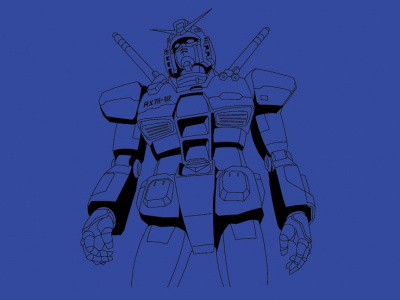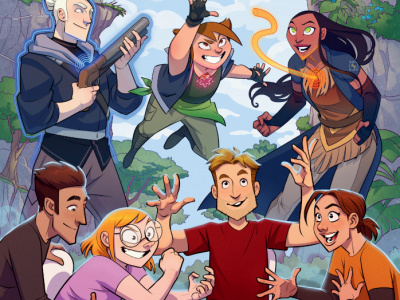
ICv2 recently caught up with Dark Horse CEO Mike Richardson. In Part 3 of his ICv2 Interview Richardson discusses the current state of the North American manga market, the revival of Dark Horse Presents, and other key Dark Horse projects for 2011. In Part 1 of the interview Richardson talks about the challenges of the current marketplace, the financial impact of Borders’ woes, the opportunities and challenges of digital publishing, and DarkHorse’s move into the digital arena. In Part 2, he discusses the success of the Troublemaker graphic novel co-written by bestselling mystery author Janet Evanovich, the potential of Frank Miller’s Xerxes, new comic book publishers with studio ties, and Dark Horse’s current movie projects.
What about the manga business? You guys seem to be in a segment that hasn’t been as affected perhaps as some of the broader changes in the manga market, particularly what’s been happening in the shojo titles. Can you talk about what you’ve been seeing in the manga market and Dark Horse’s position in it?
We entered into the manga market almost from our very first year because we had an appreciation for manga. When I started Dark Horse we were aware of Japanese comics, I had them in my collection, we were eager to bring some to America, so from the very beginning we’ve done manga. Of course, the manga that we’ve done over the years have reflected my interest and the overall Dark Horse line.
Although we’ve had all different kinds of manga, shojo has not been the largest percentage of our manga offerings. But we’ve been there from the beginning. We have the longest running manga series, we’re the longest running publisher of manga, and we’ve always had a successful program working with the greatest creators in Japan. I began going to Japan in the late 80s and continue to go there once or twice every year, and we’ve built many relationships. We have a great opportunity over there to see the material that we want to work with. As a result most recently we’ve made an arrangement with Clamp, and we have a very close partnership with them. The books that we’re releasing by Clamp, for instance, have seen tremendous success. We have more of those.
We have more announcements to make, more creators that we’re going to work with. Our manga program has always been strong. We’ve never got into it just because we thought it was a profitable market, although it has been. We were in it before the boom and we’ll be in it after the boom. Right now we’re in the after part.
Although we’ve had all different kinds of manga, shojo has not been the largest percentage of our manga offerings. But we’ve been there from the beginning. We have the longest running manga series, we’re the longest running publisher of manga, and we’ve always had a successful program working with the greatest creators in Japan. I began going to Japan in the late 80s and continue to go there once or twice every year, and we’ve built many relationships. We have a great opportunity over there to see the material that we want to work with. As a result most recently we’ve made an arrangement with Clamp, and we have a very close partnership with them. The books that we’re releasing by Clamp, for instance, have seen tremendous success. We have more of those.
We have more announcements to make, more creators that we’re going to work with. Our manga program has always been strong. We’ve never got into it just because we thought it was a profitable market, although it has been. We were in it before the boom and we’ll be in it after the boom. Right now we’re in the after part.
For us, we publish what we’re interested in and that seems to have beeen a good formula for us. We’ve always been interested in manga and we continue to be, so we’ve been successful. We’ve chased some titles for years, Gantz being a great example. We chased that title for years and it’s been a big success for us. Just saw the Gantz movie and it’s really a lot of fun. For people who follow the Gantz series they’re really going to enjoy it.
What do you think the reasons are for the drop off in manga sales over-all the last couple of years?
Well the shojo in the book stores really fired up that whole trend. The increase in graphic novel sales was largely due to shojo sales in book stores and it created more room on the racks, it created a lot of attention to graphic novels and particularly manga. And I think it was great for the industry for a while. A lot of publishers got in trying ride that wave, some were here, some were trying to cash in on it. Publishers outside the comic book industry got involved and some of the Japanese companies even came over here to start publishing here.
I have my own theories of what went on. First of all, they appealed to a certain age group that may have moved on in their reading habits. I think the financial problems at the book stores have caused them to be a little more conservative in the number of books they purchase and the number of titles. And I think like with any big surge in sales, it comes back down to earth after a certain period of time. All of those factors have flattened out sales in the manga area. For us, our books are doing well. We’re really excited. We’ve been less affected by it because we weren’t so dependent on the shojo.
There’s some decline in Japan, too. Do you think the content pipeline is as strong now as it was five years ago?
Well certainly in the U.S. it’s not, and the reason is because for a number of years there were many great series that were sitting on shelves over there to mine and to bring over here for the first time. But obviously as those books come out, the choices of what to bring, quality-wise, thin out a bit. That’s not to say that there’s not great manga being created over there, but when you can look at the body of work and most of it is unique to this market, it gives you a lot of opportunity to introduce readers to great material and as that body of work thins out, as it is presented over here, then it’s harder to find material at the same level. So certainly that has some effect also.
Plus for shojo in the book stores, you’ve got teenage girls paying $10-$11 a pop for books and they’re trying to keep up and between the publishers there’s a large number of books to keep up with. The release schedules got very aggressive and at some point they can’t keep up anymore. Having been a retailer, I remember when we used to have a term--the Marvel zombie. There was a point when people came and decided there were just too many Marvel books at one time and they wouldn’t just quit a few, they’d just quit. They were done reading comics, they couldn’t keep up any more. And maybe a little bit of that had an effect on manga sales.
We talked a little about some of your 2011 plans. What are the highlights of Dark Horse’s 2011 publishing schedule?
The big launch is Dark Horse Presents. It’s the same idea but with a different format. This time it’s coming out in full color and it’s 80 pages. We’re trying to keep it at a good price; I think we ended up at $7.99. First issue’s out in April and it’s a good price. It’s four comic books’ worth of material for about two bucks each. We’ve got a line-up that is just amazing. The first issue we’ve got Paul Chadwick with the return of Concrete, Neal Adams with his first creator-owned project in some time and it looks spectacular, Howard Chaykin is bringing a new series to us. We've got Carla Speed McNeil, who has been around for a long time but who I think has been under appreciated, so we’re going to promote her very hard. She has a series called Finder, and she’s been around for a while but I don’t think she’s ever received the attention she deserves. So we’re very excited about bringing her into Dark Horse.
We have the preview of Xerxes by Frank Miller with an interview with Frank. We’ve got Richard Corben--he has a new series.
At 80 pages are you selling that as a book or a periodical?
Comics--in the old 80-page comic format [and] sold as a periodical.
What else for 2011?
I worry about saying too much because we want to do big launches on some of these things. We have a new Buffy coming, we’re going to be launching Angel, obviously we’re hoping to get the first issue of Xerxes in 2011, and a lot of surprises.
A number of the titles that we run in Dark Horse Presents are also going to launch into their own series, and there are major creators working on these series. In our 25th year, we’re trying to go back to our roots a little bit. We’re going to use Dark Horse Presents as not only an opportunity to bring creators to Dark Horse who may be working on other series, but who can find time to do an 8-page or three 8-page episodes for Dark Horse but also to launch new characters or to to launch stories they’ve had in them, or launch new series and maybe even peek at some new licenses we have.
A number of the titles that we run in Dark Horse Presents are also going to launch into their own series, and there are major creators working on these series. In our 25th year, we’re trying to go back to our roots a little bit. We’re going to use Dark Horse Presents as not only an opportunity to bring creators to Dark Horse who may be working on other series, but who can find time to do an 8-page or three 8-page episodes for Dark Horse but also to launch new characters or to to launch stories they’ve had in them, or launch new series and maybe even peek at some new licenses we have.
You’ve done that beautiful Avatar art book, and for free comic book had an Avatar side. Can you talk about that program?
I think they’re going to start moving away from that title for obvious reasons. [We’ll be using] more Last Airbender to get away from the confusion. It’s been very successful for us. We have several projects for that title coming out. We have some of the work that was done before being included in the book; we have some new work being done. The reaction to the big art book that you’re speaking of was pretty good. It did very well, obviously we think it’s a great title for us.
Anything else going on that we should have asked about?
I think we’ve covered pretty much everything. It’s our 25th anniversary. One of our big pushes this year is going to be retailer programs. We’re really going to try to work hard with the brick and mortar stores to create some great programs. Our marketing department has really grown, and we’ve got some exciting promotional projects in mind for the retail community.
For Part 1 of this interview, click here. For Part 2, click here.
For Part 1 of this interview, click here. For Part 2, click here.







